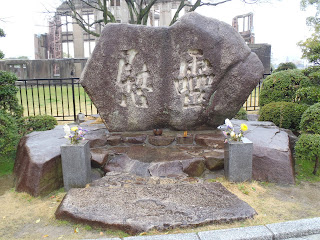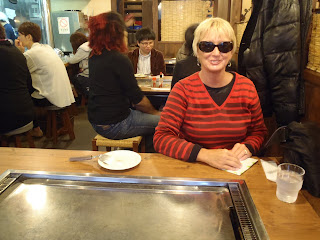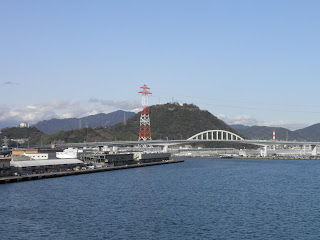We had planned to do this
day on our own with no guide or tour. The plan was to take a ferry to Miyajima (宮島) Island. We bundled up (I had storm pants and
a jacket with a hood) and stopped at the visitors center and they gave us the
ferry schedule and where to catch it. We might have made the next ferry in 15
minutes if we could have gotten a cab, but we had to walk and we got there just
a few minutes after it left. The next one was in an hour and they told us to
wait until 10:00 to buy the tickets. While we were waiting a guy came out to
tell us the ferries were canceled due to high winds.
At the ferry station I
needed a bathroom and got to use one of the “squat toilets”. In Greece I had
used ones that just had cement feet where you were to place your feet and just
a hole in the ground. Here they were porcelain basins in the floor that you
squat over. (which would have been easier to use without all the layers of
clothing I had one for the weather) Later, at the Peace Park I had the
opportunity to use them again. All part of experiencing the culture when you
travel. (the fancy heated seats we had yesterday would have been nice today…)
So, with the ferries
canceled we proceeded to the Atomic Bomb Dome and Peace Park which we were
going to visit after visiting the island. Luckily, the tram stop was right
outside the ferry terminal and we got on the 1 line to Hiroshima Station. From
there it was a short walk (which would have been beautiful minus the driving
rain…) to the Peace Park. We headed to the Memorial Museum hoping the rain
would pass before seeing the outdoor portions of the park.
I knew this would be a
somber experience and many people were crying in the museum. No matter how you
feel about the dropping of the bomb the displays and stories were gut wrenching.
The Peace Memorial Museum graphically displays the atomic bomb's horrible
effects on the city and its inhabitants. A visit is naturally depressing. In
the museum's east building, Hiroshima's militarist past and the process leading
to the dropping of the bomb are documented. In the museum's east building,
Hiroshima's militarist past and the process leading to the dropping of the bomb
are documented. Audio guides are available in more than a dozen languages.
The rain had gotten worse if anything, but we needed to power on so we bundled up again and headed out to see the Peace Park.
Between the museum and the
Atomic Bomb Dome stands the Memorial Cenotaph for Atomic Bomb Victims. It
contains a list of all the people who were killed by the explosion or died due
to the bombing's long-term effects such as cancer caused by radiation. The
Statue of the A-Bomb Children and the Cenotaph for Korean Victims are some of
many more monuments found in the park.
gotta love a squat toilet...yep, those are my feet
It was time for lunch and we
went in search of food. The was a visitor’s center and we popped in to find out
which direction we should walk for restaurants. He pointed go straight and we
did indeed find food and a huge open air, but covered mall. Just before the
mall we found a small restaurant for Japanese Pancake.
Yum!
dessert
double Yum!!
Here is a description of
Japanese Pancake: (Okonomiyaki (お好み焼き o-konomi-yaki?)
is a Japanese savoury pancake containing a variety of ingredients. The
name is derived from the word okonomi,
meaning "what you like" or "what you want", and yaki meaning "grilled" or
"cooked" (cf. yakitori and yakisoba). Okonomiyaki is mainly
associated with Kansai or Hiroshima areas of Japan, but is
widely available throughout the country. Toppings and batters tend to vary
according to region.
In Hiroshima, the ingredients are layered rather than mixed. The
layers are typically batter, cabbage, pork, and optional items such as squid,
octopus, and cheese. Noodles (yakisoba, udon) are also used as a
topping with fried egg and a generous amount of okonomiyaki sauce.The amount of cabbage used is usually three to four times the amount used in the more common Osaka style. It starts out piled very high and is pushed down as the cabbage cooks. The order of the layers may vary slightly depending on the chef's style and preference, and ingredients vary depending on the preference of the customer. This style is also called Hiroshima-yaki or Hiroshima-okonomi.
Food was fantastic and the atmosphere was very local. The cooks and waiters shout out a greeting to all that enter and shout again as you leave. We watched them make the layers of pancake on a huge cooking top griddle and cook it down. When finished they brought it to our table which had a smaller hot griddle in the middle of the table and they put it on there. We had small plates with a small spatula to serve ourselves and we ate with chop sticks. The last bite stays as hot as the first since it was kept on the heated cooking surface. Very Yummy!
The name of the restaurant was Nagata-ya and I ordered the Deluxe with pork, egg, cheese, rice cake, corn, soba noodles and garlic chips. Greg ordered the Garlic with pork, egg, kimchi, green onion, cheese and garlic chips. Both were delicious! (yes, I got pictures)
Then we were ready to finish the park. The most prominent structure is the A-Bomb Dome, located just across the river from the park. Built in 1915 as the first western-style brick building, it served as the industrial promotion hall for a prosperous city. The atomic bomb exploded 2,000 feet above the building and instantly killed everyone inside. In 1996, its stabilized ruins were declared a UNESCO World Heritage Site, a poignant reminder, much like the ruined Kaiser Wilhelm church tower in Berlin. The Atomic Bomb Dome is one of the few buildings around the explosion's epicenter that partially survived the blast, and the cities only remaining bomb damaged building.
In the park itself, there
are memorials with the names of all the known victims, a grave of unknown
persons, an eternal flame that will be extinguished when the last nuclear
weapons are destroyed, a peace bell and the most moving -- the Children's Peace
Memorial. A young girl named Sadako developed leukemia at age 12, about 10
years after the bomb was dropped; according to an old Japanese custom, if she
could fold 1,000 paper cranes, her wish to live would come true. While she
never quite made the full count, her classmates finished the task, and others
continue to make them to this day.
We had spotted a nice place
for dessert so after we finished seeing the A-Dome we headed back there. We
each got a huge sundae like any other we have ever had. There was no English
spoken and we just pointed to what we wanted. One had vanilla ice cream with
chocolate sauce, bananas, frozen strawberries and raspberries, bits of pound
cake and topped with a pastry “elephant ear” stuffed with chocolate. The other
was chocolate sauce on chocolate and vanilla ice cream with a very small scoop
of dark chocolate ice cream, bananas, a small flan, bananas, crunchy cookie
stuff and pound cake. We wandered the mall for a bit and I found a shop as I
was looking for a tori gate for Carol our table mate. All I could find was a
small Christmas ornament one, but I got one for myself and Carol. If we could
have gotten to the island I’m sure I could have found a nicer one. We wandered
a bit more and caught the number 1 tram back to the port area. As we were on
the tram the sun came out! So, now that our day was done it got nice.
We had about an hour left
after the tram dropped us off so we just walked around the area trying to find
a place to use up our Japanese Yen. Not much in the area, so we found a 7-11
and bought a couple bottles of wine and some regional snacks. Back on board we
had to go back to immigration and have our passports stamped and they collected
our cards. We then surrendered our passports to Princess as they have been
keeping them while we are on board and passing them out as we need them.
Interesting enough, all
aboard was at 3:30, but they wanted you at immigration at 3:00. Hmmmm. When we
got back to our cabin (after immigration) we had a message on our phone from
immigration to proceed immediately.
As we sailed away the locals
(officials, Visitor’s center employees and families just enjoying the day) all
waved goodbye and watched.
Since the sail in was ugly
due to the rain, the sail out in the sun was very nice. When it was time to get
ready for dinner we came in and went to dinner and the show. The show tonight
was a Classical Japanese Pianist Tomono Kawamura. She was very good!
Our too short visit to Japan
was over. We missed Cherry Blossoms in mass by about a week. I do think at one
place yesterday I saw one.
Thank goodness we have a sea
day tomorrow to get caught up!
Here is what we missed not
getting to go to Miyajima Island:
Miyajima
is quite a large island, but its attractions are concentrated in two main
areas: the small town around Itsukushima Shrine and Mount Misen.
Visitors
to Miyajima will first arrive at the ferry terminal, from where it is a ten
minute walk to Itsukushima Shrine. All the other sights are
also located within walking distance from the shrine.
Another delightful and quite peaceful experience on Miyajima is to
wander Daishoin (temple).
It's quite unique compared
to the many other temples you will likely visit. Be sure to look for the 500
stone statues of the Buddhas, spin the prayer wheels up and down the staircase,
and see the mandala and offerings to the Dalai Lama in the first building at
the top of the stairs.
Standing
in the bay in front of the shrine, the floating
torii is the "gate" to Itsukushima. Note that whether the gate
is "floating" or merely mired in mud depends on the tide.
Itsukushima Shrine (厳島神社). A UNESCO
World Heritage Site, Itsukushima is a large, red-lacquered complex of halls and pathways
on stilts, originally so built that
commoners could visit without defiling the island with their footprints
Senjokaku (千畳閣). The name means "1000
Mat Pavilion", a fairly apt description of
this gigantic wooden hall which doesn't actually contain much other than
empty space. It was originally built by Toyotomi Hideyoshi in 1587, but left
incomplete after his death. There's also a picturesque 5-story pagoda (五重塔 Gojuto)
next door, and plenty of cherry trees if you are visiting in sakura season. ¥100.
Daisho-in (大聖院), Because it's nestled into
the hills, this Buddhist temple is easily missed by tourists, but it features a
number of interesting sights and a welcome respite from the crowds. Look for
the Dai-hannyakyo Sutra (大般若経), the golden prayer wheels that are said to
bring enormous fortune to anyone who touches them, and the Henjokutsu Cave (遍照窟), a fascinating and eerie collection of
Buddhist icons related to the 88
Temple Pilgrimage in Shikoku.
Mt. Misen (弥山), For the best panorama,
follow the signs to Misen, a 1,730-foot peak, best reached by using a two-part
cable car. Getting off, there are deer and monkeys to amuse you and a
15-to-20-minute walk to the top. There are views in all directions. Allow an
hour to retrace your steps if entirely on foot. Mount Misen can be accessed by the Miyajima Ropeway,
whose lower station is a ten minute walk from Itsukushima Shrine. There are
also three hiking trails from the town to the mountain's summit.
Momijidani Park (紅葉谷公園). The ropeway station is in
the middle of Momijidani Park, but the park is worth a stroll even if you're
not headed up. Known for its autumn colors, there are quite a few quiet little
temples to explore along the way, and many of the island's hotels are tucked
away here.





























































































No comments:
Post a Comment